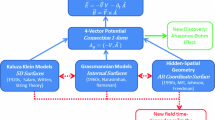Conclusion
It is now a broadly-admitted fact that gauge theories provide intense research stimulation for both mathematicians and physicists. We tried to show that, as far as bundles and connections are the adequate minimal concepts to formalize the very act of beings which produce their own space in a consistent way, or, which is the same, the very act of informing a basis world B through a parametrized space of operations E, gauge theories realize a true translation between geometrical and physical information.
In Section I.A, we tried to show how the concept of communication via experimentation finds this equivalence and makes a necessary collision between mathematics and physics.
We gave some striking theoretical and practical facts: the obtaining of interaction Lagrangians, Higgs phenomenon and good energy behaviour of graphs arising from broken symmetries, the ‘miraculous’ encounter between connection and path integral formalism. We could have added the relation with twistor theory, the theory of strong interactions, super gravity theories where the basis world B is not even a manifold. Some authors even speak of geometrodynamics and ‘pregeometry’ [21] and would like to understand physics as a cosmogony.
In a way, this makes us understand Einstein's unsatisfied mind when he wrote down his famous equation. The equivalence between a curvature tensor and an impulsion-energy tensor requires a careful analysis of the act of setting consistent spaces (via experimentation) when one doesn't reduce material beings (monads) to material points ruled by the universal Newton's observer.
So, as far as gauge theories pretend to found and explain the process of translation between Geometry and Physics, they provide an extremely solid epistemological basement for the so-called mathematical Physics.
Similar content being viewed by others
References
Asorey, M. and Mitter, P., ‘Regularized Yang-Mills Process’, Preprint, Université Paris VI, 1980.
Atyah, M.F., ‘Fermi Lectures’, Ann. Scol. Nor. Sup. Pisa (1980).
AtyahM.F., HitchinN.J., DrinfeldV.G., and ManinY.I., Phys. Letters 65A, 185, (1978).
AtyahM.F., HitchinN.J., and SingerI.M., ‘Self Duality in Four-Dimensional Riemannian Geometry’, Proc. Roy. Soc. Lond. A362, 425–461 (1978).
BelavinA.A. and PoliakovA.M., JETP Lett. 22, 245 (1975).
BourguignonJ.P., LawsonH.B., and SimonsJ., ‘Stability and Gap Phenomena for Yang—Mills Fields’, Proc. Nat. Acad. Sci. 76, 4 (1979).
BohmD. and AharonovY., ‘Significance of Electromagnetic Potentials in the Quantum Theory’, Phys. Rev. 115, 3 (1959).
Chern, S.S., Complex Manifolds Without Potential Theory, Van Nostrand, 1967.
FaddeevL.D. and PopovV.N., ‘Feynmann Diagrams for the Yang—Mills Fields’, Phys. Lett. 25B, 1 (1967).
Feynmann, R. and Hibbs, A.R., Quantum Mechanics and Path Integrals, McGraw-Hill, 1965.
Fueter, R., ‘Function Theory of a Hypercomplex Variable’, lectures, University of Zurich, 1948.
Gribov, Quantization of Non-abelian Gauge Theories, Leningrad Nuclear Physics Institute, 1978.
Goldstone, Nuovo Cimento 19, 154 (1961).
Gürsey, F., ‘Complex and Quaternionic Analyticity in Chrial and Gauge Theories’, preprint, Yale University, 1979.
HiggsP.W., ‘Spontaneous Symmetry Break Down Without Massless Bosons’, Phys. Rev. 145, 4 (1966).
't HooftG., Nucl. Phys. B33, 173 (1971).
Husemoller, D., Fiber Bundles, McGraw-Hill series in higher mathematics.
Mitter, P., ‘Geometry of the Space of Gauge Orbits’, Cargese Lectures, 1979.
Mitter, P. and Viallet, C., ‘On the Bundles of Connections in Yang—Mills Theory’, Preprint, Université Paris VI, 1979.
NarashimanM.S. and RamadasT.R., ‘The Geometry of SU 2 Gauge Fields’, Comm. Math. Phys. 67, 121–136 (1979).
Patton, C. and Wheder, J., ‘Is Physics Legislated by Cosmogony?’ Quantum Gravity, Oxford symposium, 1975, p. 538.
Singer, I.M., ‘On the Gribov Ambiguity’, Comm. Math. Phys. 60 (1978).
Taylor, J.C., Gauge Theories of Weak Interactions, Cambridge Univ. Press, p. 58.
WardR.S., Phys. Lett. 61A, 81–82 (1977).
Weyl, H., ‘Gravitation und Electrizität’, Preuss Akad. Wiss., 465–480 (1918).
WeinbergS., ‘General Theory of Broken Local Symmetries’, Phys. Rev. D7, 1068 (1973).
WeinbergS., ‘A Model of Leptons’, Phys. Rev. Lett. 19, 1264 (1967).
YangC. and MillsR., ‘Conservation of Isotopic Spin and Isotopic Gauge Invariance’ Phys. Rev. 96, 191 (1954).
CornwallJ.M., LevinD.N., and TiktopoulosG., Phys. Rev. D10, 1145 (1974).
Author information
Authors and Affiliations
Rights and permissions
About this article
Cite this article
Chatelet, G. Mathematical and physical aspects of gauge theories. Lett Math Phys 5, 1–29 (1981). https://doi.org/10.1007/BF00401823
Received:
Issue Date:
DOI: https://doi.org/10.1007/BF00401823



